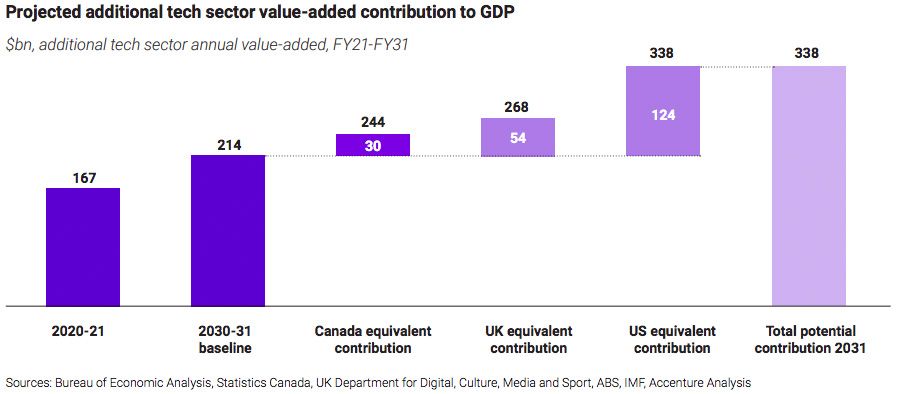[ad_1]
The Technology Council of Australia has commissioned consultancy Accenture to undertake a strategic market assessment of Australia’s technology sector to shape policy development for what is now the country’s third largest industry, behind mining and banking. 10 charts from the sector growth and outlook report.
The technology sector is a critical pillar of the Australian economy, contributing $167 billion to the economy. The sector’s contribution has increased by 79% since 2016 and more than quadrupled the average growth of other industries, partly due to an acceleration due to accelerated digital adoption during Covid-19.

The technology sector is currently the third largest contributor to GDP in Australia, behind mining and banking and ahead of healthcare, construction and retail.

The technology sector’s direct contribution is $76 billion. This segment includes value generated by categories such as software, analytics, business applications, technology intelligence, technology enabling infrastructure, e-commerce, digital media and online payment solutions.

Most of Australia’s direct technology contribution comes from technology services and intelligence.

However, technology’s indirect contribution is larger at $92 billion. In today’s digital era, technology is a strong part of the value chain and operations of most businesses in the economy from traditional areas such as agriculture, retail and manufacturing to service businesses such as finance and professional services.
The growth potential of the technology sector means it will actively consolidate its place as a pillar of the Australian economy over the next decade, surpassing the contribution of primary and manufacturing industries.

Employment in the technology sector
The technology sector is one of the largest generators of quality jobs across a wide range of skills in Australia. Technology jobs are essential to the growth of technology firms and industries that use technology in their businesses, such as banking, agriculture, mining, retail and manufacturing. Meanwhile, tech firms are also creating broader job opportunities as they hire support occupations in non-technical roles such as sales and marketing, administration, human resources and legal.
Since 2005, the number of jobs in the technology sector has grown by 66%, compared to an average growth rate of 35% for the entire economy.

In terms of total jobs, the technology sector is the seventh largest employer in Australia.

Tech job growth has diversified outside of major capital cities and is strongest in regional and suburban areas. The highest growth rates for ICT professionals are mostly in Sydney and Melbourne suburbs, including Sydney’s Outer South West (including Campbelltown, Camden and Narellan) and Melbourne West (including Sunshine West, Williamstown and Altona).
Five of the 10 fastest growing regions for ICT professionals are in South East Queensland, with the highest average growth rate recorded in East Brisbane. Regional cities, including Adelaide and Hobart, also saw high growth in the number of ICT professionals.

Strengthening the impact of the sector
According to a report by the Technology Council of Australia and Accenture, while Australia’s technology sector has seen strong growth in recent years, ongoing barriers to innovation and development have limited its size relative to peers. For example, the direct technology sector contributes 3.8% of Australia’s GDP, significantly less than the US (10.2%), UK (8.1%) and Canada (6.8%).
As a result, Australia has a significant opportunity to increase the economic contribution of the technology sector to catch up with its global counterparts. For example, if Australia matches Canada’s contribution in the technology sector (Canada is chosen as a benchmark because it has a similar economy to Australia with a dominant agriculture and mining sector), then it could generate an additional $30 billion in economic value per year by 2031.

If ambitious targets were set and Australia matched the current UK or US contribution over the next decade, it could achieve an additional economic value of US$54 billion to US$124 billion per year by 2031.
This additional growth could provide a strong boost to employment in the technology sector. Under a growth scenario where Australia can match Canada’s technology sector, the technology sector will employ 1 million people by 2025, or an additional 141,000 workers over the next five years. Under the UK or US scenarios, between 277,000 and 638,000 additional workers could be employed annually in the technology sector by 2031.

Commenting on the report, Kate Pounder, CEO of the Technology Council of Australia (and former consultant to Accenture and McKinsey & Company), said: “The tech sector has matured and accelerated during the Covid-19 pandemic and is now one of the most important drivers of growth in the economy , which contributes 8.5% to GDP and employs one in 16 Australians.
“By addressing the challenges in the sector and catching up with global peers, Australia can deliver a technology-led recovery, deliver (hundreds of) thousands of new jobs and contribute billions a year to GDP. Government in partnership with industry should play a key role in seizing this opportunity.
[ad_2]


